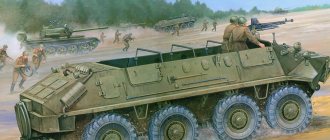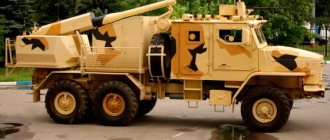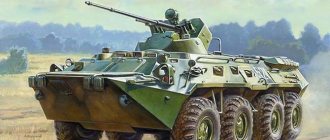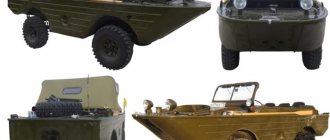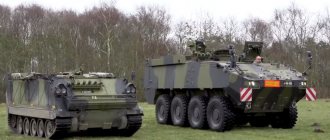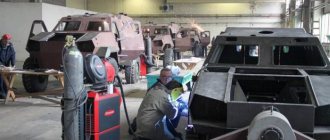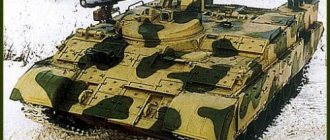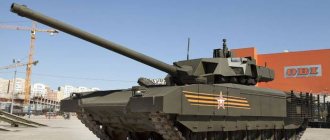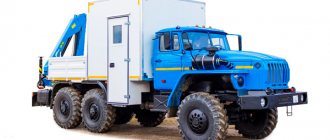Floating wheeled armored personnel carrier BTR-70
In 1971, a prototype of the GAZ-50 wheeled infantry fighting vehicle was produced, developed by the design bureau of the Gorky Automobile Plant on the basis of units and components of the BTR-60PB. The wheeled infantry fighting vehicle had the same weapons and turret as the BMP-1. The troop compartment of the new vehicle could accommodate eight infantrymen. The GAZ-50 infantry fighting vehicle was not mass-produced for various reasons, but its chassis was used to create the BTR-70 armored personnel carrier, which was put into service on 08/21/1972.
In general, the layout of the BTR-70 is similar to the BTR-60PB. The control compartment with the driver's and vehicle commander's seats is located in the front of the armored personnel carrier's body. Behind the control compartment is the troop compartment, and the engine and transmission compartment is in the aft part.
The driver and commander of the vehicle outside the battlefield monitor the environment through two windshields, which are equipped with a heating device and a windshield wiper. The windows in the combat position are covered with armored covers. In this case, the commander observes through the TNPKU-2B device and three TNP-B periscopic devices, and the driver uses four TNP-B. To enter the control compartment there are two hatches in the roof of the hull.
The closed, hermetically sealed body of the BTR-70 is welded from rolled armored steel sheets. The thickness of the frontal parts is 8-10 millimeters. The tower is also of welded construction, its thickness in the front part is 6 millimeters. The height of the hull and armored personnel carrier decreased by 185 millimeters compared to the BTR-60PB.
Important new elements of the hull were small lower side hatches mounted on both sides of the hull between the third and second pairs of wheels. The hatches are intended for covert dismounting and landing of troops. Additional hatches are also available in the roof of the troop compartment.
The troop compartment can accommodate six motorized riflemen. They are placed facing the sides on the seats, which makes it possible to fire directly from their seats. For this purpose, there are six embrasures on the sides of the hull, closed with armored covers. A TNP-B device is installed on each side of the troop compartment for surveillance. Another paratrooper is placed in the front, the machine gun gunner is on the other side.
The BTR-70 armored personnel carrier has the same weapons as the BTR-60PB: a 14.5 mm KPVT machine gun and a 7.62 mm PKT machine gun are installed in an armored turret with circular rotation. They also developed a prototype BTR-70 with an AG-17 automatic grenade launcher mounted on the turret, but this model was not mass-produced.
The armored personnel carrier is equipped with a high-power power plant. In the rear part of the hull, in the engine-transmission compartment, two GAZ-49B eight-cylinder V-shaped carburetor engines (each with a power of 120 hp) are installed on a common frame. Oil cooling is carried out in two heat exchangers and radiators. The use of carburetor engines running on gasoline is associated with an increased fire hazard. To reduce fire hazard, fuel tanks are installed in isolated compartments, and the armored personnel carrier is equipped with an automatic fire extinguishing system. The driver's seat is equipped with a system for disconnecting the power transmission from the engine, which makes it possible, if one of the engines fails, to quickly turn it off and continue driving on a working engine.
The chassis, like that of the BTR-60PB, is made according to the 8x8 wheel arrangement. The first two pairs are controllable, with a minimum turning radius of 12.6 meters. The suspension is torsion bar, the wheels have split rims, low-pressure tires, tubeless, measuring 13.00 x 18 inches. The armored personnel carrier is equipped with a centralized tire pressure regulation system. The presence of powerful compressors in this system makes it possible to regulate the pressure depending on the conditions and compensate for the loss of pressure when the tire goes flat.
The maximum speed of the BTR-70 armored personnel carrier when driving on a highway is 80 km/h. The armored personnel carrier has high maneuverability over rough terrain. He overcomes water obstacles by swimming at speeds of up to 10 km/h. Movement through the water is provided by a two-stage water jet propulsion system. Power reserve afloat is 12 hours.
BTR-70 with a turret from the BTR-80
During the development of the BTR-70, considerable attention was paid to its equipment for conducting operations in conditions of the use of nuclear weapons, as well as other means of mass destruction. The armored personnel carrier contains a DP-3B radiation reconnaissance device, a filter-ventilation unit consisting of an absorber filter and a supercharger-separator, a set for special equipment. processing and military chemical equipment. VPHR intelligence.
The equipment of the armored personnel carrier includes: a tank intercom, a radio station R-123M, a heater, towing devices and a winch for self-pulling (traction force 6 thousand kgf).
Performance characteristics of the BTR-D
Crew, people: 3 Troops, people: 10 Manufacturer: Volgograd Tractor Plant Years of production: 1974 Layout: engine and transmission compartment at the rear, controls and landing compartment at the front
Weight BTR-D
– 8.0 tons
Dimensions of BTR-D
– Body length, mm: 5883 – Body width, mm: 2630 – Height, mm: 1650–2000 – Ground clearance, mm: adjustable, 100–450
BTR-D armor
– Armor type: rolled aluminum – Hull front, mm/deg.: 15 – Hull side, mm/deg.: 10 – Hull rear, mm/deg.: 10
Armament of the BTR-D
– Machine guns: 2 × 7.62 mm PKT or PKTM
BTR-D engine
– Engine type: 5D20 – Engine power, l. p.: 240
Speed of BTR-D
– Speed on the highway, km/h: 60 – Speed on rough terrain, km/h: 10 afloat – Cruising range on the highway, km: 500 – Specific power, l. s./t: 30
– Suspension type: individual hydropneumatic – Specific ground pressure, kg/cm²: 0.5 – Climbable grade, degrees: 32 – Crossable wall, m: 0.7 – Crossable ditch, m: 2.5 – Crossable ford, m : floats
The history of the creation of the BTR-50P tracked amphibious armored personnel carrier
The tactical and technical assignment issued by the GBTU immediately provided for the creation of two new combat vehicles - a light amphibious tank and an armored personnel carrier based on it with the maximum possible unification of the design components and assemblies. The new Soviet armored personnel carrier was created jointly by the designers of VNII-100 (Leningrad), the Chelyabinsk Kirov Plant (ChKZ) and the general management of the project was carried out by the famous Soviet tank designer Zh. Ya. Kotin.
Work on creating new combat vehicles in the USSR began on August 15, 1949, and the technical design of the new armored personnel carrier was ready on September 1, 1949. In the same year, design work on the creation of a light amphibious tank and tracked armored personnel carrier was moved to Chelyabinsk, where the projects were designated “Object 740” (future PT-76) and “Object 750” (future BTR-50P).
From the very beginning of work, Soviet designers were faced with the task of creating a tracked amphibious armored personnel carrier designed to transport personnel of motorized rifle units of the Soviet Army, as well as various military cargo, including artillery pieces and light wheeled vehicles in conditions of possible fire resistance from a potential enemy.
Work on the tank and armored personnel carrier was carried out in parallel, but the armored personnel carrier was created somewhat behind schedule. This delay was justified by the development of a large number of design solutions, for example, a water-jet propulsion system, first on the PT-76 light amphibious tank. It was the successful tests of the PT-76 that gave the designers confidence that the work on creating the armored personnel carrier would be completed in the same successful manner.
BTR-50P
One of the requirements of the technical specifications when creating a new combat vehicle was the transportation of two tons of various cargo, including divisional artillery and the GAZ-69 SUV. While working to solve this problem, the designers encountered difficulties in choosing a loading device. Two main options were considered: an electric crane and a winch driven by the main engine of an armored personnel carrier with loading on folding ramps. During the work, the option with a crane was abandoned due to the excessive design and operational complexity of this solution.
An interesting fact is that already during testing of the new tracked armored personnel carrier, the designers, on their own initiative, fired on land and afloat from transported artillery systems: the 57-mm ZIS-2 anti-tank gun and even the 85-mm D-44 cannon. Technical specifications from the military did not provide for such tests; the only requirement was the transportation of divisional artillery.
To the surprise of many, the shooting was successful and did not lead to breakdowns in the chassis of the armored personnel carrier or any incidents. Moreover, the vehicle’s buoyancy reserve turned out to be quite sufficient for firing from a transported gun without flooding or capsizing the armored personnel carrier, which only confirmed the very high amphibious capabilities of the new vehicles.
Light amphibious tank PT-76
The first prototype of a tracked armored personnel carrier was ready by the end of April 1950; from April 26 to June 11 of the same year, the armored personnel carrier underwent factory tests. The tests carried out made it possible to adjust the technical documentation for the new combat vehicle; already in July, two new prototypes of the Object 750 were ready, state tests of which were carried out in the second half of 1950.
Based on the results of state tests, the vehicle was once again modified, and in the third quarter of 1951, ChKZ submitted two more prototypes for testing, which passed the stage of military testing the following year. The military noted the insufficient strength of the design of the wave-reflective shield, the unsatisfactory accuracy of the fire of the standard weapons - the large-caliber 12.7-mm DShK machine gun, as well as cases of spontaneous activation of fire-fighting equipment.
After eliminating all the shortcomings indicated by the military and modifying the armored personnel carriers, they underwent control tests in the fall of 1953, covering a total of 1.5 thousand kilometers. In April of the following year, the new armored personnel carrier was officially adopted by the Soviet Army by order of the USSR Minister of Defense under the designation BTR-50P.
The new Soviet combat vehicle was unique in many of its characteristics and was a completely domestic development, which was created without regard to foreign models of similar equipment. Moreover, the PT-76 amphibious tank with powerful artillery weapons, on the chassis of which the BTR-50P was created, was a one-of-a-kind vehicle. In many ways, the creation of such equipment was helped by the extensive experience in developing light amphibious tanks, which was accumulated in the USSR even before World War II.

